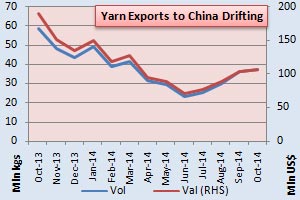
Spun yarn export declines sharply, apparel also slows down
YarnsandFibers News Bureau 2014-11-25 17:33:00 – MumbaiA weaker rupee and steady demand from China and US had helped the textiles exports in the past year. From April, demand for raw material like yarn from China has fallen dramatically and inventory levels have risen. Further, falling cotton ribre prices have been asserting pressure on yarn pricing and cutting unit value realisation, although rupee continues to remain weak.
Spun Yarn Exports Plunge
In October, spun yarns exports declined sharply in October, after declining in single-digit in September. During the month, over 107 million kg of spun yarns were exported worth US$343 million or Rs 2,100 crore. Compared to last year, volumes were down 22 per cent while US$ term value fell 29 per cent implying fall in unit price realization. Rupee appreciated 0.5 per cent against the US$ in the comparable months. Overall unit price realization averaged US$3.19 /kg, down US cents 5 from previous month and US cents 31 from October 2013.
During the month 82 countries imported spun yarn from India with China at the top. It accounted for 31 per cent of India's total spun yarn exports, declining gradually from 39 per cent in the same month last year. Volumes declined 36 from last year while value plunged 44 per cent YoY to US$106 million. Cotton yarn, although accounted for almost all the yarns in October, exports declined 36 per cent in volumes and 44 per cent in value. Unit prices realisation were US cents 41 lower than last year at US$2.83 per kg.

Bangladesh, the second spun yarn importer from India accounting for 13 per cent of all spun yarn, has reduced its imports by almost 8 per cent in value but still positive 0.4 per cent in terms of volumes. Egypt was the third largest importer of Indian spun yarns in October, followed by Turkey and Vietnam which continues to be the fast emerging markets for Indian spun yarns. Turkey's imports increased 18 per cent in October while Vietnam's imports grew 39 per cent. While most of the other major markets registered fall, the fast growing markets for Indian spun yarns in October were Venezuela, Taiwan, and Guatemala.
Cotton yarn worth US$285 million (Rs.1,735 crore) was exported in October from India to 71 countries with volumes totaling 88 million kgs. The unit price realization averaged US$3.22 a kg on an average. This was US cents 33 down compared to same month a year ago and US cents 6 from last month. Vietnam was the fast growing major markets for Indian cotton yarn in October, climbing to third position. South Korea, the fifth largest export market for cotton yarn saw shipment shrink to half during the month.
Man-made fibre spun yarn exports continued to declined in October, but the space slowed down considerably. Unit value realization saw improvement for acrylic yarns. In October, ex-ports of manmade fibre yarns declined 4 per cent in value terms. A total of 6.05 million kg were exported, comprising 2.77 million kg of polyester yarn, 2.16 million kg of viscose yarn and 0.39 million kg of acrylic yarn. Polyester yarn exports fell 2 per cent in value while viscose yarn export was down 16 per cent during the month. Unit price realization was down US cents 12 for viscose and US cents 22 for polyester from last year. Acrylic yarn export fell 3 per cent to US$3.32 million, but unit price realization jumped US cents 78 to US$5.54 per kg.
Blended spun yarn export aggregated 13.3 million kg valued at US$41 million, mainly compris-ing 7.7 million kg of PC yarns worth US$22.2 million and 4 million kg of PV yarns valued at US$12.6 million. Venezuela was the largest importer of PC yarn from India followed by Egypt, amongst the 50 countries that imported PC yarn from India in October. Turkey continued to be largest importer of Indian PV yarns in October with volumes at 2.65 million kg valued at US$8.1 million, followed by Iran and Brazil.
Apparel Exports also Shrinking
Garment export growth also slowed down to 16 per cent in September, after an impressive growth of 23 per cent year-on-year recorded in August. However, the situation was still better than the last year, given the unfavourable conditions now. Apparel and garment exports hit US$1.3 billion, up from just over US$1.1 billion a year ago.
The robust growth in August took the total exports during the period April-September to US$8.3 billion, up 17.6 per cent compared to exports in the corresponding period a year ago. The growth was aided by an almost steady orders inflow from US and Europe as well as a weak rupee. The growth was also supported by increased labour cost in China, non-compliance of large number of factories in Bangladesh, high rate of inflation, currency appreciation, with the competing countries providing a relative advantage opportunity for India.
Market Intelligence
Ask for free sample Report

experience
Customer Base
dedicated team
Countries Served Worldwide









